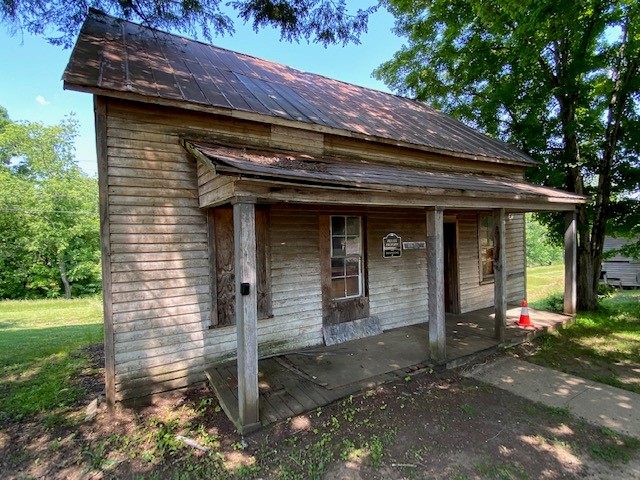The World of Panem
Interpreting Society, Geography, and Characters of the Hunger Games
Visiting the “Seam” at Henry River Mill Village

It would be a shame to find oneself only an hour away from a famous Hunger Games filming site without paying a visit to this hallowed ground. Some friends and I thus took an opportunity to check out the current scene on a beautiful May afternoon of 2021.
The real history of Henry River Mill Village began around 1905 with the establishment of a textile mill by the Henry River Manufacturing Company. The nearest town of Hildebran is located only one mile north of the mill and is just off of Interstate 40 in western North Carolina. As of 2019 the remaining structures at the site included the original company store building and 20 nearly identical wood-frame homes of former textile workers–many of them in serious disrepair. The original village had included 35 houses, and the mill itself had been closed in 1970 before being consumed by fire in 1977. Since then the village’s boarding house has also been destroyed, which once sat just to the left of the company store. Fans will recognize the village in various scenes within “The Hunger Games” film to represent Katniss’ own coal-patch town, the Seam. The old company store, for instance, served as the Mellark bakery, and one of the dilapidated houses featured as the Everdeen residence (interior and exterior pictured below).
What may be less familiar is the site’s more recent developments well after the filming. Following the Village’s abandonment since the 1990s, the place is now being transformed as a visitor attraction. The entire village property was purchased in 2017 by Calvin Reyes and his parents. In the spirit of transforming historic structures to more contemporary purposes—defined as adaptive re-use—Reyes has restored one of the houses and has converted the entire village property into a visitor destination. Due in part to its fame as a popular filming location, the outdoor site is also monitored more thoroughly with video surveillance. The previous owner had less control over trespassing and the vandalism that occasionally came with it. Likewise, activities for visitors are now more organized and prescribed in the form of scheduled tours.
Not knowing what to expect upon arrival, we found a simple metal shipping container in the small parking lot next to the company store, and we wondered where everybody was. After milling around a bit (pun intended), an enthusiastic fellow emerged from the trailer to greet us, confirming that he would be our tour guide of the site as well (I had purchased tickets online, if I recall). With no one else around, the three of us enjoyed our own private tour and some wonderful tidbits about both the filming and the site’s history. Perhaps the most explosive (pun intended) bit of information was his revelation that the filming crew blew up one of the remaining derelict houses to film the flashback scene of the mine explosion. Upon later browsing in the budding gift shop, he further revealed the true control the company held over its employees and families, right down to the separate currency the company distributed for use in its own company store (pictured below). Not to neglect, of course, that true moment of fandom when you stand in the very Everdeen residence where Katniss, Prim, and their Mother kicked off the movie.
Fans will also recall the scene by the old dam within “The Hunger Games” film, which Katniss scoots across during her early hunting foray. This scene was filmed here as well. After concluding our guided tour, we ventured downhill to see if we had visual access to the reservoir and dam. No luck. Any access was completely overgrown by thick vegetation, and we risked venturing onto private property. Thus, we did not succeed with the “dam tour” on this visit. Our guide explained that the filming crew had gained permission from the owners. But no matter, we enjoyed complete freedom to stroll around the remainder of the village after our tour. We even discovered that the property is now popular for weddings, with an old church window serving as a makeshift altar in the village’s own meadow (photo below).
Although certainly not a realistic coal-town landscape as portrayed within the saga by author Suzanne Collins, I believe the decision to portray the Seam here in Henry River was as good as any, especially given the educational opportunities provided by an actual company town. With no running water and scant electricity even during the mill’s heyday, this provided for a much more realistic filming location than the back lot of a Hollywood studio.
Here’s the web site for Henry River Mill Village.













